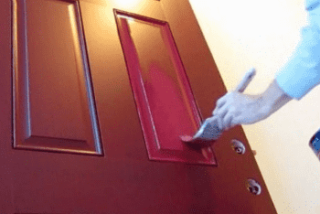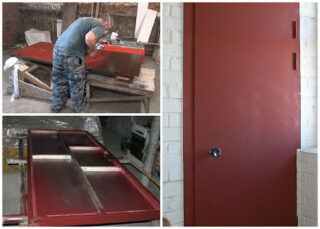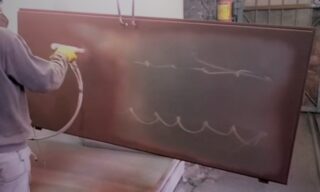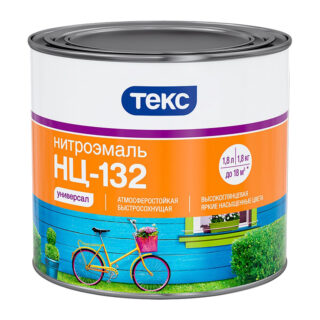Metal structures are characterized by high strength and durability, but require decoration, protection from the influence of negative factors, rusting. To paint the front door correctly, you need to take into account its location, the risk and frequency of the influence of precipitation, negative temperatures. Responsibly, you need to approach the choice of finishing material, since not every composition fits well on the metal.
Varieties of paints for metal doors

The choice of the coloring composition depends on what properties need to be given to the structure. Some serve to protect the door surface from the influence of ultraviolet rays or give it anti-corrosion properties. Others provide visual appeal.
Powder paints
You can paint metal doors with powder paint. It creates a high quality finish that is considered elite. Such a finishing material has a long service life, it is durable, and withstands atmospheric influences well. The composition is environmentally friendly, resistant to inflammation. The advantage is a wide range of colors of powder paints. They create a good decorative composition on textured surfaces.
It is impossible to apply the coating on your own; this requires a special chamber in which statically charged particles are sprayed onto a grounded base. To strengthen the layer, the structure is baked at a high temperature. The entire coating cycle takes 10-30 minutes.
Powder paint has the following advantages:
- durability (the service life of the coating is at least 10 years);
- high mechanical resistance;
- impact strength;
- low consumption (if the powder does not settle on the door the first time, it can be reapplied);
- the ability to withstand severe temperature changes.
After applying the composition, a seamless coating is created on the doors. Powder paint can only be used on heat-resistant surfaces.
Hammer paint

The hammer paint contains an epoxy or alkyd-styrene base, which is mixed with aluminum powder. The last component makes the coating as durable as possible. After applying the material, a rough texture is created on the surface. It eliminates defects of varying severity, so it can be used for heavily damaged structures. In this case, preliminary stripping is optional. Hammer paint has the following advantages:
- resistance to the influence of atmospheric phenomena;
- the possibility of self-application on the surface;
- no need to prepare the door;
- long service life;
- protection of the metal sheet from oxidation, rusting;
- burnout resistance;
- the ability to create a pronounced effect by applying several layers of the composition.
It is necessary to use the material in moderate humidity, as well as in the presence of personal protective equipment. It is suitable for interior and exterior entrance doors. Apply paint with a roller in several layers, the procedure can be carried out independently. If the paint is too thick, you can add a little thinner to it.
Due to the presence of aluminum powder in hammer paint, the use of a spray gun becomes problematic.
Nitroenamel, alkyd-based paints
It is better to use this mixture for decorating the structure, since it bonds poorly to the base and has low mechanical strength. For a good result, apply at least 6 coats of enamel. In this case, the surface will be unstable to weathering and temperature extremes. It can be applied to the inner surface of the front door of the apartment.
The disadvantage of nitro enamel is its toxicity, therefore it is necessary to work with it in a respirator. If the door was painted with other compounds, they must be removed. Otherwise, it will not be possible to provide the required level of adhesion to the surface. With increased humidity inside the room, whitish stains appear on the surface of the structure.
Alkyd paints create a durable elastic coating that protects the door from corrosion. The layer does not lose its technical and decorative properties at temperatures from -50 to +60 degrees. The product is produced on a melamine, glyphthalic, pentaphthalic base. The coating is resistant to chemical attack. The disadvantage of alkyd enamels is the presence of toxic components and a high fire hazard. You need to work with them carefully, wearing protective clothing and a respirator.
Acrylic based paints
The paint contains acrylates, due to which a polymer film is formed on the surface of the door, which can last at least 7 years. The structure acquires good resistance to weathering and mechanical damage. Acrylic compounds have good adhesion to metal surfaces, are highly resistant to wear and temperature extremes. You can dilute the composition with plain water.
The paint does not contain toxic components. After drying, such a coating darkens, so it is not always possible to achieve the desired shade. At the same time, the surface is resistant to sunlight. The coating is durable. The composition of acrylic paints includes special components that ensure reliable adhesion of the finish even to a rusty surface.
Even when the structure is deformed, the acrylic layer does not crack, as it has good elasticity.
Paint selection rules

It will not work to paint iron doors with any composition. When choosing the right paint, you need to consider the following factors:
- the quality of adhesion of the material to the door surface;
- the presence of an old finish layer (acrylic paints should be used only on a previously cleaned base, otherwise they will quickly peel off);
- the method of applying the composition (at home it is better to use aerosol cans, in this case the coating will lie flat);
- location of the door: the design used in a private house is more demanding in the choice of finishing material;
- color;
- technical characteristics of the paint: the durability of the coating and its decorative effect depend on them.
It is better to buy the product in certified stores. Do not give preference to materials that are too cheap.
Preparation for staining

In order to properly paint the iron doors with your own hands, the base must first be prepared. The quality of the finish depends on this. The work involves the following manipulations:
- Remove all elements that should not be painted: handles, linings, glass.If this cannot be done, all parts that will not be processed are sealed with masking tape and film.
- Removing dust from the surface: use a damp cloth for this. If there are greasy stains, you can clean them with acetone or white spirit, as well as special products designed for metal doors.
- If the structure needs to be repainted, it is better to remove the old finish layer.
- To remove traces of rust, use a remover or sandpaper.
- If necessary, the surface of the doors is treated with a metal brush, which improves adhesion to the paint.
- Before applying the composition, the base must be degreased.
- In the presence of chips, dents, irregularities, you can get rid of them with the help of putty (an automobile mixture is best suited), and after processing the door is sanded with fine sandpaper.
Before starting painting, you also need to prepare all the necessary materials and tools.
To improve the adhesion of the finishing material to the door, it is better to treat the surface of the base with a primer. This will help extend the life of the coating.
Required tools and materials
The correct selection of tools will allow you to finish quickly and efficiently. For work you will need:
- aerosol can with the selected paint, spray gun or roller;
- metal bristle brush or sandpaper for surface preparation;
- putty for removing scratches and dents;
- a primer to improve the adhesion of the finishing material to the door leaf;
- masking tape, plastic wrap;
- acrylic topcoat varnish.
Work is carried out in protective clothing, rubber gloves and a mask.
Features of painting a metal door with your own hands

It is possible to paint the door from the outside, provided the weather permits (relevant for a private house). The work is carried out in the following sequence:
- Preparing the door. All elements that should not be processed are removed or sealed with plastic wrap, masking tape.
- Elimination of dust and dirt. Greasy stains are removed with white spirit. It is better to remove the old paint coat. To do this, use a metal brush, a chisel. You can remove rust with sandpaper.
- Surface treatment with abrasive material. This will improve the adhesion of the finishing material to the substrate.
- Degreasing the canvas. Without this procedure, the paint will peel off quickly enough. For processing, special compositions for metal doors or white spirit are used.
- Sealing flaws. Chips, cracks, dents are removed with automotive filler. After the solution has dried, the surface of the door is treated with fine-grained sandpaper, wiped with a damp cloth.
- Base priming. This procedure is necessary to create maximum paint adhesion to the canvas. It is recommended to use an aerosol primer or liquid used on metal damaged by rust.
- Application of finishing material. The most convenient way to paint is with an aerosol can. First, it is shaken to achieve a uniform consistency of the substance inside. It is better to apply paint from top to bottom: this way, you can avoid the appearance of drips. The can is kept at a distance of 30 cm from the surface.
Apply 2-3 layers of paint. In this case, you need to ensure that each previous one is completely dry before applying the next one. The interval between reapplications is 1-2 hours. Do not paint a metal door in winter or wet weather. After applying the last layer, the structure should dry out within 4-5 hours.
If you need additional protection of the canvas, giving it shine, increasing the color depth, you can apply acrylic varnish in the form of an aerosol. It dries up in 2 hours. After completing the painting, all removed accessories and decorative elements are installed in place.









